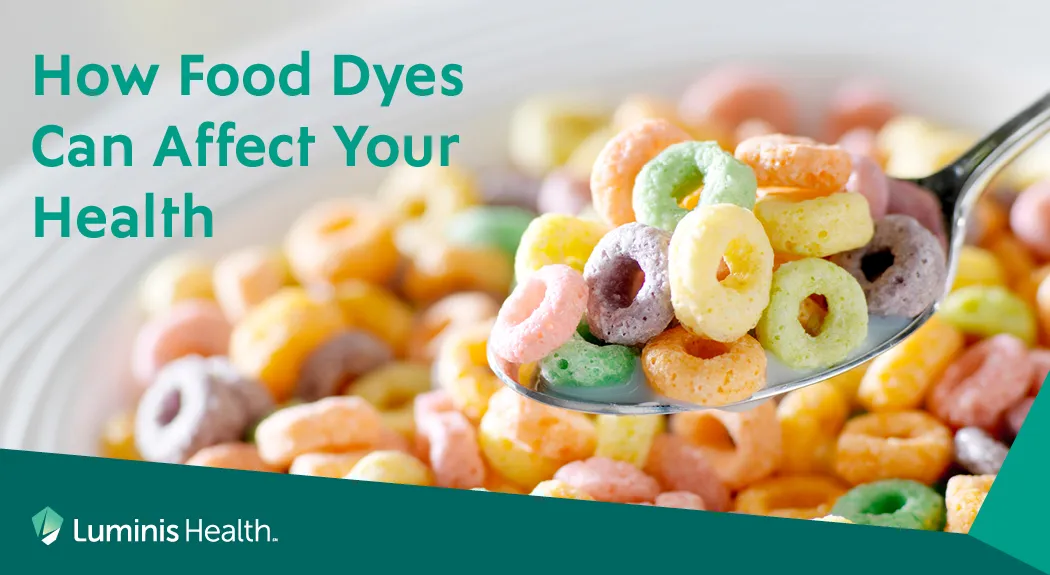
You’ve probably heard about the nationwide debate on the safety of food dyes. The Food and Drug Administration (FDA) has proposed phasing out artificial food dyes by 2027. It has left parents with many questions.
The hard truth? If you’ve noticed your child building up nervous energy or getting cranky after a bright red candy or neon-yellow sports drink, it’s likely a reaction to the dyes. In fact, studies have shown kids with attention deficit hyperactivity disorder (ADHD) may be more sensitive to food dye compared to other children.
But here’s the good news: Increasing awareness of how your kids respond to dyes, along with ideas for limiting exposure to them, can go a long way toward keeping your family healthy.
What are food dyes?
Food dyes are chemicals added to foods and drinks to enhance their color. You’ll often find them in candy, cereal, sodas, sports drinks, fruit snacks and even healthier foods like yogurt. In the United States, the most common food dyes include:
- Red 3
- Red 40
- Yellow 5
- Yellow 6
- Green 3
- Blue 1
- Blue 2
These dyes are usually made in a lab using synthetic materials such as petroleum. They don’t provide the body with any nutrients; they are there solely to make foods and beverages more visually appealing.
How do food dyes affect behavior?
Food dyes can affect a person at every age and stage of life, but they seem to affect growing children most significantly.
According to researchers, there’s a strong connection between food dyes and behavior problems like hyperactivity. This means your children may have trouble sitting still, focusing on tasks or staying calm after eating foods with dye.
It’s important to remember though, that all children are unique and react in different ways. Some feel fine after; others are more sensitive; and some have an actual allergy to dyes. For this reason, it’s important to pay attention to any changes in your child’s behavior after eating or drinking foods with dyes.
How do dyes affect the body?
The link between food dyes and health is still being explored. But scientists suspect that food dyes affect several physiological functions, including brain function, hormone levels and the immune response.
Children who are sensitive to food dyes may experience bothersome symptoms like:
- Anxiety
- Headache
- Hyperactivity
- Irritability
- Itchy rash
- Trouble focusing
Some recent research also suggests that certain dyes can disrupt the balance in your child’s gut and cause inflammation, which is the body’s way of reacting to something it dislikes. Over time, this can make it harder to maintain good health.
Children who are allergic to food dyes will experience more severe—and sometimes life-threatening—symptoms like:
- Breathing trouble
- Dizziness or fainting
- Feelings of impending doom
- Hives
- Low blood pressure
- Sudden and debilitating headache
- Swelling in the face, lips, tongue or throat
- Tightness in the chest
If your child has mild reactions to food dyes, it’s important to talk with a doctor right away. A skilled care team can help you pinpoint the cause of your child’s symptoms and create a plan to help manage them. Your doctor may also connect you to an allergist for specialty care if needed.
More severe and concerning reactions may point to a dye allergy. Seek emergency care right away or call 911 if your child has severe swelling, trouble breathing, faints or has chest pain.
What can we do about it?
Fortunately, you can take steps to protect your family. Start by:
- Increasing your awareness about food dyes and how your child responds.
- Planning meals and snacks around dye-free foods, such as fruits, veggies, eggs, oatmeal and other unprocessed foods.
- Reading labels on packaged foods and drinks to eliminate ingredients like Red 40, Yellow 5 and Blue 1.
- Talking to your child’s school about offering snacks that don’t have artificial dyes.
- Trying dye-free brands of their favorite foods. Many companies are using natural colors like beet juice, turmeric or carrots.
We’re in this together
Food should help us feel good, both inside and out. If your child experiences symptoms after eating or drinking, and you suspect dyes may be the culprit, our team is here to help.
Our dietitians can help you identify which foods work best for your family and support you in making informed, nourishing choices. If you’re concerned that food dyes may be affecting mental health or behavior, our behavioral health specialists can help you understand, manage and prevent related challenges.
 Colleen Kiley, MS, RD, is a lead diabetes educator for Luminis Health Diabetes and Endocrine Specialists. To make an appointment, please call 443-481-6700.
Colleen Kiley, MS, RD, is a lead diabetes educator for Luminis Health Diabetes and Endocrine Specialists. To make an appointment, please call 443-481-6700.



